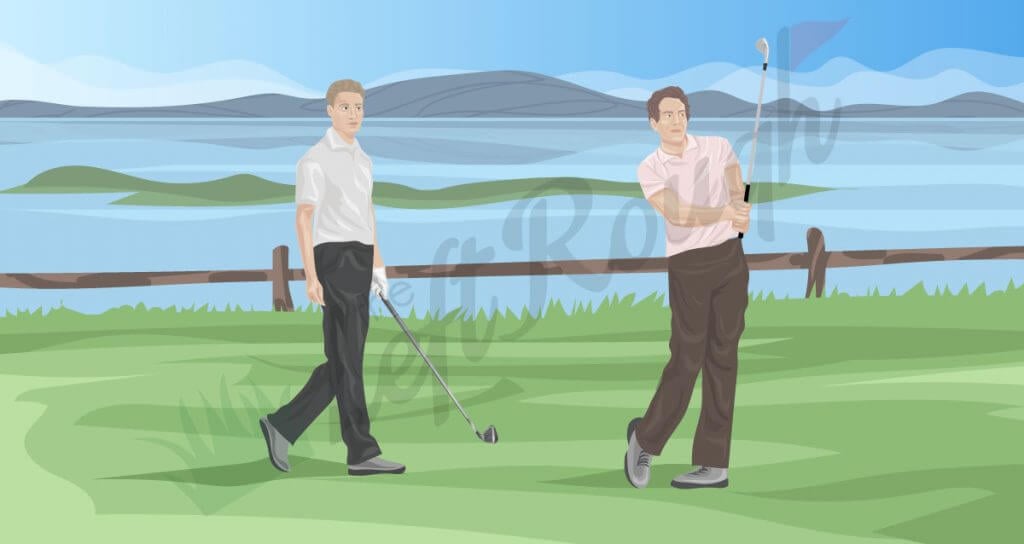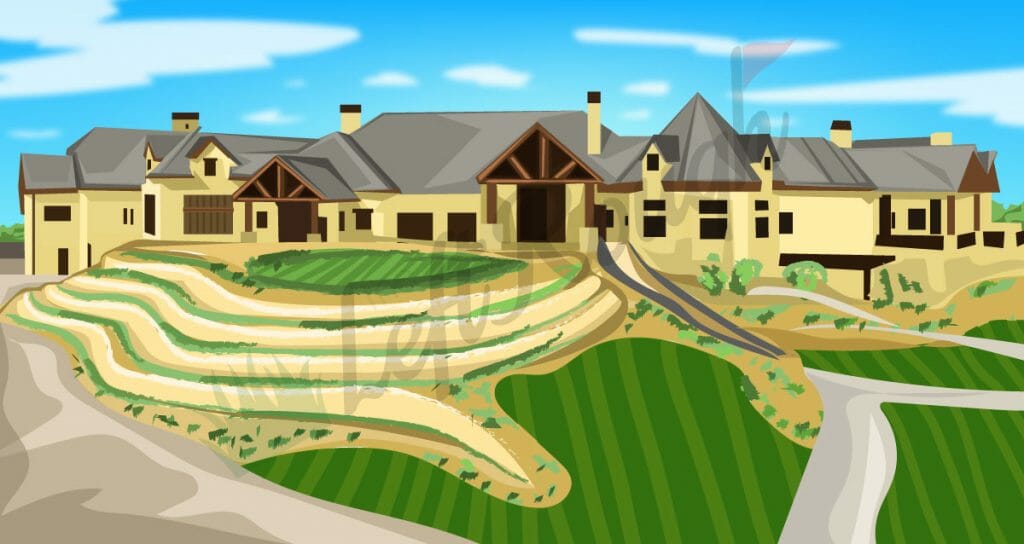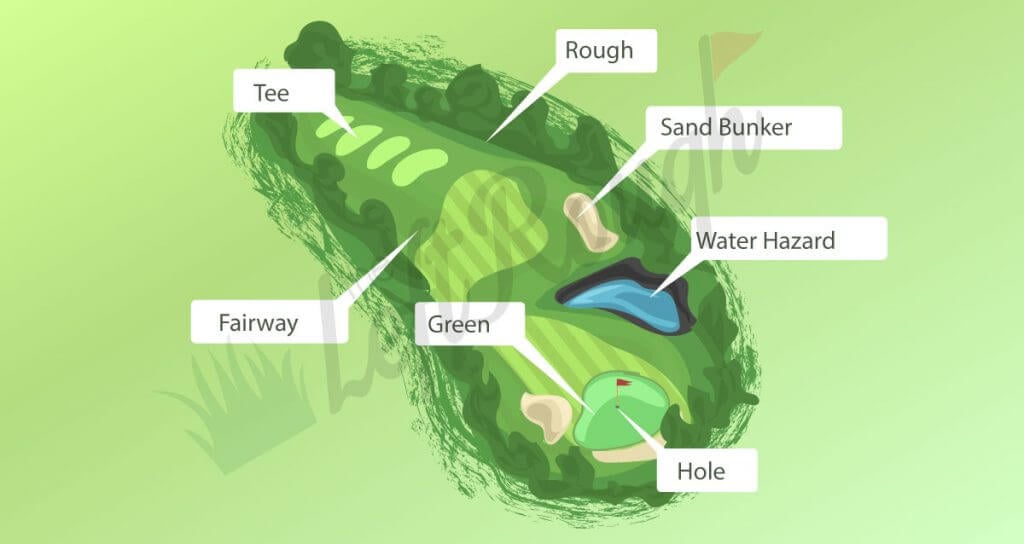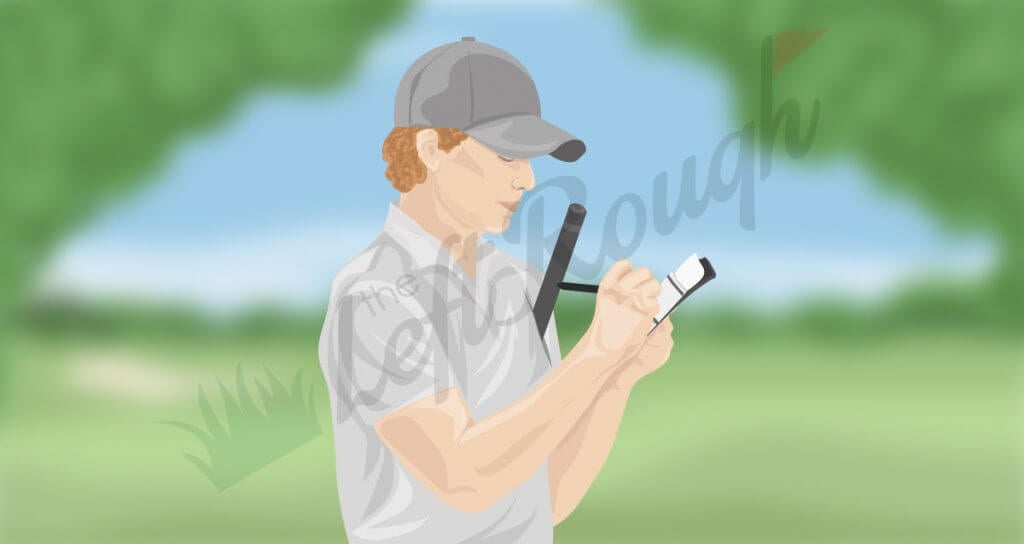If you are a brand-new golfer, you might get confused when you hear the endless amount of golf terms. You probably hear things on the golf course like “Bite, snowman, eagle or shank” and have no idea what they mean.
Don’t worry, every golfer was once there. If you are just starting your golf journey, we got you covered. While it’s important to know common golf terms like birdie, bogey or par, there are a lot of other ones as well.
If common golf terms seem like a new language, you are going to want to keep reading. In this post, we will cover the most common golf terms for beginners. Plus, we will help you level up your golf vocabulary by learning common golf slang as well.
By the end of this post, you will talk like a seasoned golfer in no time.
Key Takeaways
- There are so many terms in golf, it can feel like you’re learning a new language as a beginner.
- Common terms refer to golf clubs, how the golf ball moves in the air, different types of tee shots, and more.
- As a beginner, focus on your golf swing fundamentals and keep learning more terms as you progress in your golf journey.
Basic Golf Terms For Dummies: Scoring 101
Before getting into common golf swing terms, let’s start with scoring as it’s one of the most confusing part of the game for new players.

Ace – Hole in One
An ace, commonly known as a hole-in-one, is the best score out there. When you get an ace, that means you get to write a “1” on the scorecard. While they rarely happen, they usually happen on par-3’s but can happen on par 4’s as well.
Also, don’t forget the hole-in-one rule. If you get a hole-in-one, it’s common practice to buy your group or anyone in the clubhouse an adult beverage to celebrate. Personally, I’ve never understood this rule and feel like people should buy you a cold one…but it’s still important to remember.
Albatross (Double Eagle)
Very few golfers have the honor of getting an albatross, which is commonly known as a double eagle. This would mean that you hole out your second shot on par 5.
Eagle
Eagles are more common than the previous two golf terms but still rare for most amateur golfers. An eagle is two shots below par. So if you’re playing a par-5, you score a 3 on the hole.
These are most common on Par 5’s as golfers can hit on in two shots and make a putt for eagle. But if you can get near or on a short par-4, you can also sneak an eagle there as well.
Birdie
This is a golf term that, hopefully, you become very familiar with because golfers love birdies! A birdie is one shot below par.
For example, if you’re playing a 432 yard par-4, a birdie would mean you scored a 3 on the hole.
If you noticed the names above are all birds, go here to learn all about the golf scoring names and why birds?
Par
“Par” represents the number of strokes a scratch golfer should make on the hole. Each hole has a “par” that is assigned to it based on difficulty and length.
Holes are either a par-3, par-4, and par-5. On most traditional courses, there are four par-3’s, ten par-4’s and four par-5s. But some courses have six of each par hole and/or different combinations as well.
For the majority of amateur and pro golfers, par is almost always a good score. If you hear someone say they shoot “par golf” this means their scoring average is around 72.
Bogey
A bogey” is used when a golfer finishes the hole one above par. If you hear golfers say “I shoot bogey golf”, they are referring to averaging a bogey per hole.
This would mean that they shoot a 90 on a par 72 golf course.
Double Bogey
A double bogey is one more than a normal bogey. For example, if it’s a par 4, a double bogey means the golfer scored a six on the hole.
Triple Bogey
A triple bogey is three shots above par. You might also hear the abbreviation, “trip” if a golfer doesn’t want to speak this score in full.

Match Play vs. Stroke Play
Stroke play is the most common way to score a round of golf. Simply add up the number of strokes it takes to complete the hole – from tee shot to holing out on the green, write on the scorecard, and add up after the round.
Match play is quite different and where you play vs. one other person or team in a head to head format. This is common in team events like the Ryder Cup and Presidents Cup (which each happen every other year). In match play, you can only win or lose the hole by one, even if there is a big scoring differential.
To learn more about match play, check out our full guide here.
Golf Terminology for Beginners
Now that you understand the basic golf terms for scoring, it’s time to dive into other popular terms to up your golf vocabulary. Start using a few of these terms each round to sound like a more seasoned player.

Club House – Pro Shop
The clubhouse is the building where you will check in and pay for the round (also called a pro shop). If it’s a country club, there is usually a restaurant, locker rooms, and sometimes a gym and other facilities as well.
Types of Golf Clubs
Each golf club plays a pivotal role in helping you hit different shots during a round. Here is a quick breakdown:
- Driver: The longest club in the bag, used on the tee box on most par 4s and par 5s.
- Fairway wood: It’s common for players to have 2-3 fairway woods, depending on handicap and skill level.
- Hybrid: A hybrid, or rescue club, is part iron, part fairway wood. This club is very forgiving and much easier to hit than long irons.
- Irons: Every golfer will buy a set of irons that make up the middle of the set. These are broken into long irons, mid-irons, and short irons.
- Wedges: Wedges are similar to irons, but shorter and have more loft. Every iron set comes with a pitching wedge, while most golfers add a sand wedge and some add a gap or lob wedge too.
Using the right golf club for a specific shot played makes it much more likely to execute it properly. All clubs go in your golf bag and the most clubs you can use are 14 according to the USGA. But you can always use less if you’re a beginner and just starting out.

Caddie
A caddie is a person that is hired to carry your clubs and give advice during the round. Caddies tend to have extra course knowledge and can help you shoot lower scores.
Another type of caddie is a “fore-caddie.” A fore caddie will walk ahead of your shots to locate them and provide help to your entire group. They usually ride in a cart or walk and don’t carry your clubs.
Fore
Fore is one of the most commonly used golf terms ever! If you hear the word “fore” you need to head for cover and protect yourself.
Golfers yell the word “fore” when a golf ball is flying toward another player or group of players. If you hit anywhere near another golfer, it’s common courtesy to always yell fore.
Tee Box
The tee box is where you hit your tee shot for each hole. Make sure that you always tee your ball up behind the tee markers, or there is a one-shot penalty.
Fairway
The fairway (commonly known as “the short stuff”)describes the shorter-mown area of a course between the tee box and the green. This is where you ideally want your tee shot to land.

Hitting your golf ball into the fairway is ideal for several reasons. First, the grass is shorter than the rough which means your lie is more predictable. It’s easier to determine what the ball will do and easier to pick the right club for the shot.
Another reason to hit the fairway is that it is usually the most direct route to the hole. This can make it easier to hit your approach shots. For most golfers, there is almost a direct correlation to hitting more fairways and shooting lower rounds.
Green
The green is where the hole and flag are located – known as the putting surface. A commonly tracked metric is “greens in regulation.”
For example, if you are playing a par-4, you should hit the green in two shots. Similar to hitting fairways, the more greens you hit, the easier it is to score low.
Fringe
The fringe is the collar of higher mown grass that surrounds the green. It’s just longer than the green and shorter than the rough and where you might hit a chip shot. If you hit the fringe, this doesn’t technically count as a green in regulation, but you can often putt from it like a green.
Rough
The rough on a golf course is the longest grass that surrounds the fairway and green. If you hit a shot into the rough, it usually results in a tougher next shot.
Depending on the golf course you are playing, the rough length can vary greatly. Some courses, hitting in the rough can add a lot to your score, while others it’s less of a factor.

Other golf courses also have two different types of rough, known as the intermediate rough and the deep rough. Intermediate rough is usually still playable and very easy to find the golf ball. But deep rough is often much more difficult and might require you to just chip out to the fairway.
Two different cuts of rough are more common in tournament golf and higher end courses. For example, the U.S. Open tends to have the longest, most penalizing rough ever. Links golf courses might also have deep rough known as fescue which is nearly impossible to hit out from.
The main point…find the fairways as often as possible!
Putt
A putt is when you are on a green and using your putter. If you are using your putter from the fringe or fairway even, it technically doesn’t count as an official putt.
The goal is to have as few putts as possible. It’s most common to have a one-putt, two-putt or three-putt. While you can have a zero-putt (holding one from the fringe) or a four-putt, they are less common.
Putts are also tracked on a per round basis. The fewer the putts, the lower the score!
Bunker
A bunker is a sand trap. Bunkers are constructed to make holes more difficult and challenging for all skill levels of golfers. There are two types of bunkers; greenside bunkers and fairway bunkers.
Greenside bunkers, as the name implies, are near the green. These bunker shots are normally short (less than 30 yards) and require a sand or lob wedge to get out.
The other type of bunkers are fairway bunkers. These shots are much longer and are placed strategically on par 4’s and par 5’s. These shots require creativity and strategy based on the lie, distance, and other factors.

Slice
A slice is a very common shot among amateur golfers. This golf shot is when the ball curves left to right in the air for a right-handed golfer. This type of shot is the most common in golf for both left and right-handed golfers (for lefties, the shot shape curves right to left).
A slice occurs when the club head is open at impact position. If it’s wide open, it’ll create a slice and if it’s slightly open, it will create a fade, which is a coveted shot in golf.
Hook
A hook is the opposite of a slice. For right-handed players, a hook goes hard from right to left in the air. A hook is a tough shot to deal with too, as it can lead to some big misses on the golf course.
This golf shot occurs when the club head is closed at impact position. If the club isn’t closed too much, this produces a draw. This is one of the most sought after shots in golf and leads to more distance.
Go here to read about all the different types of golf shots.

Links Golf Course
Links is a common golf term that can be used in a variety of ways. You might hear the term “links golf” which refers to old-school type courses that are found in Europe. Links golf courses are usually flat and have bigger greens than most US courses.
You might also hear “Let’s hit the links” which just refers to going out and playing a round of golf.
Slope and Course Rating
The slope is a golf term that measures the difficulty of a golf course. When looking at a scorecard, you can determine the difficulty based on the slope and distance of the course.
This number tries to determine how hard a course is for the average amateur golfer. Slope ratings can range from 55-155. The higher the slope, the more difficult the golf course. We’ve got a full article on slope rating here.
Scratch
A “scratch” golfer is what almost all amateur golfers strive for. A golfer who has played at a “scratch” level means they have a handicap of 0. These highly skilled golfers usually shoot par or better on the course.
Learn more about becoming a scratch golfer here.
Handicap
A handicap is the measurement of the average number of strokes over par during a round. For example, if you are a 10 handicap, you should shoot around an 82 (10 shots more than par). If you’re a scratch golfer (or a zero), you should shoot around 72.

Handicaps are great because it allows you to compete with any skill level golfer. For example, if you’re a 10 handicap and you’re competing against a 4 handicap, they have to give you six shots during the round.
According to the United States Golf Association, the average male is a 14 handicap, while the average female is a 27 handicap.
Pull/Push
If you hit a shot left (for a right-handed player) but it goes straight, this is known as a pull. The opposite is known as a push or blocked golf shot.
These are more common than a straight shot – a shot that Tiger Woods once said is the hardest shot to hit when playing golf.
Short-Sided
If you hit your approach shot to the side of the green where the pin is located. For example, if the flag is back right on a green, you would short-side yourself by hitting it long or right. Try to avoid short-siding yourself, as it makes for a more difficult chip or pitch.
Ready Golf
To improve your golf game and speed up the pace of play, it’s recommended to play ready golf. This is when you’re ready, even if you’re not the furthest from the hole (compared to traditional “honors” golf).
Provisional Ball
If you think you might have a lost ball situation on a golf hole, you want to hit a provisional. This is where you’ll hit the same shot again in case your original ball lands (or ends up) out of bounds
They’re most common on tee shots and why you always want to carry extra golf balls.
Click here to learn more about provisional in golf.

Funny Golf Terms For Beginners
Now that we covered the most common scoring golf terms and popular ones, let’s dive into some funny golf terms as well.
Mulligan
Every golfer should know the definition of a mulligan. A mulligan is when you re-hit your previous shot because you didn’t like the outcome of the shot. Mulligans are commonly used among beginning golfers.
If you are playing with friends, you might get “first hole mulligans” as you aren’t warmed up. Mulligans aren’t able to be used in tournament golf and you would have to take a penalty.
Chunk (Fat) or Thin (Skinny)
A chunk is when you hit way behind the golf ball and take a big divot. The shot usually doesn’t go very far and ends up short of your intended target. You might also hear “I hit it fat” as well.
The opposite of the chunk is when you hit it thin or “skinny.” This means you hit the ball with the lower grooves on the club and the ball goes farther than normal.

Gimme Putt
A gimme is when a very short putt is given to you by your playing partners. These are typically 1, 2, and maybe 3 foot putts.
A short putt is usually identified as a “gimmie” if it’s inside the leather. This means if the putt is shorter than the length of your putter.
Scramble
Scramble has two different meanings in golf. If you’re playing a tournament, you might have a “scramble” format. With these types of tournaments, it’s a team event in which you all play the best ball off the tee and on the approach.
The other definition of the term “scramble” means you’re missing fairways or greens from a faulty golf swing and still making pars. For example, you might hear golfers say, “I didn’t hit it well, but I was scrambling out there.”
Flop Shot
A flop shot is a shot that goes very high in the air and lands softly. To hit a flop shot, players typically use a lob or sand wedge. This shot has been popularized by short game wizard Phil Mickelson, and other PGA Tour pros.
If you want to learn how to hit a high, soft shot, make sure to click here.
Yips
All golfers fear two things; the yips and the shanks. The yips are a condition in which a muscle spasm or mental block prevents golfers from simple tasks. It usually happens on the putting green more than anything.
Players who suffer from putting yips tend to make a very jerky swing motion in their putting stroke that results in a poor putt. It’s often times as much of a mental issue, but can be mechanical as well.
First Tee Jitters
The first shot of the day is intimidating for a lot of golfers, as you’re having to tee off in front of others. Not to mention, it’s the first shot of the day, too. If you get nervous hitting tee shots on the first hole, this is known as first tee jitters.
Shank
A “shank”, commonly known as “The S Word” is another nightmare among all golfers, even pros! A shank is a shot that is hit off the neck or heel of the golf club, which promotes it to shoot right immediately.

This is often a “contagious” shot among your foursome. If you ever witness a shank, make sure you don’t say it out loud, as it’s commonly known as a bad omen!
Lip Out
A lip out is when the golf ball looks like it’s going to drop, but instead changes directions and stays out of the cup. A less drastic version of the lip out is a “burnt edge.”
Topped Shot
A topped shot is another embarrassing golf shot that plagues amateur golfers. A topped shot happens when the bottom of the golf club strikes the top half of the ball. The result is a golf ball that only travels a few yards.
Snowman
While not as dreaded as the “Y” or “S” word above, a snowman is a round killer. A snowman is an 8 on the scorecard as it closely resembles a snowman.
Waggle
A waggle is a motion or several motions designed to help golfers relax at address position. Instead of sitting the club down behind the golf ball, a player will make 1–3 waggles.
This is more common among older generations, but there are a few tour pros that still do it, like Jason Dufner.

Fried Egg
A fried egg is a commonly used slang term and a situation that most golfers hope to avoid. When you get a fried egg lie in the bunker, the golf ball is usually slightly buried in its own pitch mark in the sand. These shots require more finesse as you normally can’t generate any spin as well.
FAQs about Common Golf Terms
Do you have more questions about the most common terms in golf? If so, keep reading to learn more now.
What is the best shot in golf called?
There isn’t necessarily a best shot, but you want to have as many birdies, eagles, and pars as possible. If you can ever sneak in an albatross or hole-in-one, congrats to you!
Where does the term golf come from?
The word “golf” was first mentioned in 1457 on a Scottish statute. Its original meaning is “to strike or cuff.”
What is a condor in golf?
A condor in golf is 4 under par on a single hole. Good luck making an ace on a par-5!

What does bite mean in golf?
The word bite in golf is when a player wants the ball to land quickly and stop. Usually, if you hear the word “bite” the ball is traveling too far or too fast. You might also hear “sit” as well.
My Experience
Golf is many things, but simple is usually not a term that we use synonymous with the game. It is a complex sport – from the golf clubs you use, types of games (stroke play vs. match play), golf swing terms, and other jargon. But once you hit a few good shots, it’s easy to fall in love with the game.
Final Thoughts of Golf Terms
As you can tell, there are a lot of different golf terms out there. The more you play golf and play with different people, the more you will learn.
If you’re just getting started, make sure you first memorize the basic scoring terms. This will make it easy for someone in your group to keep score and not sound like a total beginner. And while you’re at it, make sure to learn how to read a golf scorecard and what the symbols on a scorecard mean.
As you get more experienced, you will start to recognize and use new golf terms (such as strokes gained) as well.
After you’ve memorized all of these terms, head over to our post on the best golf tips so you can start playing better or check out the Most Common Myths about Golf.



Thank you for the clarity. I have not hit a golf ball since college
and though I did well, I remember little. However someone gave
me a set of golf clubs recently, at age 69; and of course I want to
have at least a modicum of knowledge of the game. Next, a lesson.
Thank you for this nice, abbreviated lesson on golf terms. I have only palyed a few games so far and am enjoying the game of golf. Looking forward to joining a league.